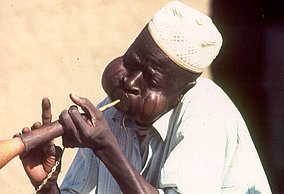The Project

In close collaboration with linguists from the University of Maiduguri it will be examined, how in the languages of the region the grammatical change proceeded and new grammatical categories evolved. As there are text documents up to 400 years old, it is possible to document the recent changes. As the processes of change differed according to the respective region and period of time, it may be possible to make statements about the ways of distribution.
Grammatical descriptions of the same language may vary. Different factors may be the cause for this, e.g.
- The absurd assumption that languages can be divided into categories like ‘primitive’ and ‘developed’ prevented an adequate grammatical analysis (19th - early 20th Century).
- Earlier descriptions (19th - mid 20th Century) are inspired by the description methods of European languages. Therefore, they do not detect the actual grammatical categories of the investigated language.
- The investigated language varieties may vary.
- Depending on the approach of the investigator, the outcome may be more diachronic or more synchronic. The diachronic approach goes deeper into the original concept of a grammatical category, but it may overlook the process of language change subsumed under grammaticalization.
- The linguistic methods applied were inadequate for an adequate grammatical description.
The contents of the project
In a first, step the causes of different interpretations of grammar will be examined. In a second step the question will be treated, whether we are ever able to describe a language adequately. First, it will be examined, how the innovative categories in terms of their grammatical classification are perceived. Then, the question will be, whether and how the newly created categories have an impact on the contact languages in the region.
In the 19th and the first half of the 20th Century grammar descriptions often followed the categories of European languages. Later, more ‘objective’ methods were applied, but there were ongoing misjudgments about the languages of Africa. Until the first half of the 20th Century, sometimes languages were even labelled ‘primitive’. For example, the Hamitic theory ‘scientifically’ supported such unsustainable allegations.
Differences in modern language descriptions
Even modern grammars may differ from each other in their descriptions. Grammatical rules are interpreted by the individual speakers differently. Linguists may also reach different analyses. Processes of grammaticalization are contributed to the ongoing change. Speakers’ perception of these new categories may vary, depending on their age, sociolinguistic environment, multilingual competence, etc.
The research area
In the west of Lake Chad in Nigeria, an enormous dynamism of language change could be observed. The political upheavals and the spread of the Hausa contributed to these changes. Thus, the Kanuri language being a language of wider communication was replaced by Hausa from the 20th century.
Areas of investigation
- Sequence of processes of grammaticalization in Kanuri
- Perception of the new grammar categories by the individual speakers
- Borrowing from Hausa and Kanuri into the contact languages
- Intensity of acquisition
- Reformulation of grammatical categories
- Findings on language typology, language contact and language universals
- Genealogy and areality: where does genealogy step back and the contact comes in?





